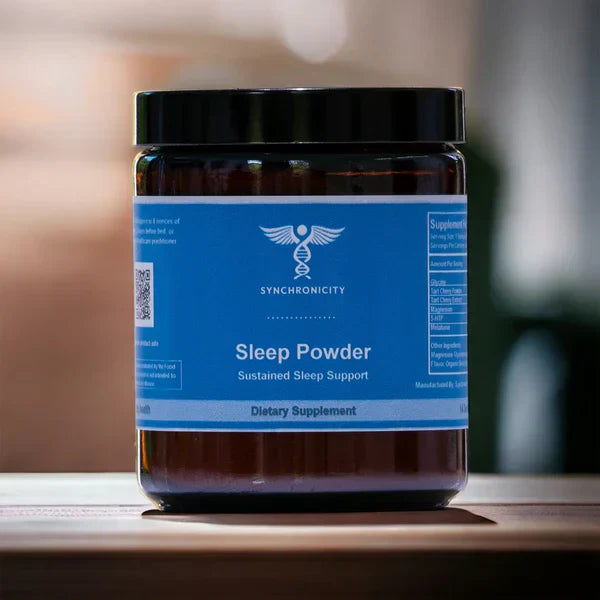When shopping for magnesium supplements, you've likely encountered confusing terminology that leaves you wondering about the real differences between various forms. Two of the most popular chelated forms—magnesium glycinate and magnesium bisglycinate—often create confusion among health-conscious consumers. While both are considered premium forms of magnesium, understanding their distinctions can help you make the best choice for your wellness goals.
At Synchronicity Health, we believe in transparency and education. This comprehensive guide will clarify these differences and help you understand why we've chosen specific forms for our premium formulations.
What Is Magnesium Glycinate?
Magnesium glycinate is a chelated form of magnesium where one magnesium atom is chemically bound to one glycine amino acid molecule. This chelation process creates a stable compound that your body can absorb more efficiently than non-chelated forms.
Key Benefits of Magnesium Glycinate:
- Enhanced Absorption: The chelation protects magnesium from interference by other minerals
- Gentle on Stomach: Less likely to cause digestive upset compared to magnesium oxide or sulfate
- Calming Properties: Glycine itself has relaxing effects on the nervous system
- Versatile Uses: Commonly used for sleep support, anxiety relief, and muscle relaxation
- Common Applications:
Many people turn to magnesium glycinate for evening supplementation due to its calming properties. The glycine component can help promote relaxation and support healthy sleep patterns.
Is Magnesium Glycinate the Same as Bisglycinate?
This is one of the most frequently asked questions we receive. While closely related, these forms have important structural differences that affect their properties and effectiveness.
What Is Magnesium Bisglycinate?
Magnesium bisglycinate takes chelation one step further. In this form, one magnesium atom is bound to two glycine amino acid molecules, creating what's often considered a more stable and bioavailable compound.
Understanding the "Bis-" Prefix:
The prefix "bis-" means "two," indicating that each magnesium atom is chelated with two glycine molecules instead of one. This double chelation provides enhanced protection and stability as the compound travels through your digestive system.
Key Characteristics:
- Double Chelation: Two glycine molecules per magnesium atom
- Superior Stability: Better protected against stomach acid and enzymatic breakdown
- Enhanced Bioavailability: Potentially higher absorption rates
- Gentler Action: Even less likely to cause digestive issues
Is Magnesium Bisglycinate the Same as Glycinate?
No, they are structurally different. While both are chelated forms,magnesium bisglycinate chelate contains twice the glycine content, which can impact both absorption and the supplement's calming effects.
Magnesium Bisglycinate vs Glycinated
Some manufacturers use "glycinated" as a general term for any chelated magnesium form, but true bisglycinate specifically refers to the 2:1 glycine-to-magnesium ratio.
Glycinate vs Bisglycinate: Is There a Real Difference?
Thedifference between magnesium glycinate and magnesium bisglycinate lies primarily in their molecular structure and resulting benefits:
Structural Differences:
- Magnesium Glycinate: 1 magnesium + 1 glycine molecule
- Magnesium Bisglycinate: 1 magnesium + 2 glycine molecules
Practical Implications:
Absorption Efficiency: The double chelation inbisglycinate vs glycinate provides enhanced protection through the digestive system, potentially leading to better absorption rates.
Glycine Content: Bisglycinate provides twice the glycine per dose, which may enhance the calming and sleep-supporting effects since glycine itself has neurological benefits.
Stability:Glycinate vs bisglycinate magnesium comparison shows that bisglycinate remains more stable in various pH conditions, from stomach acid to intestinal alkalinity.
Is Magnesium Bisglycinate Same as Glycinate?
While both are excellent choices, they are not the same. The structural difference affects bioavailability, stability, and the amount of beneficial glycine you receive.
Magnesium Glycinate and Magnesium Bisglycinate Which is Better?
The answer depends on your individual needs, but bisglycinate generally offers superior absorption and tolerability due to its enhanced chelation structure.
Absorption & Bioavailability Compared
Understanding bioavailability is crucial when choosing between these forms. Both chelated forms significantly outperform non-chelated magnesium supplements, but there are subtle differences worth noting.
Chelation Benefits:
- Protection from Interference: Other minerals and compounds in your digestive system can interfere with magnesium absorption. Chelation creates a protective cage around the magnesium.
- pH Stability: Chelated forms remain stable across the varying pH levels in your digestive tract.
- Enhanced Transport: The amino acid chelation helps facilitate transport across intestinal walls.
Is Magnesium Bisglycinate More Bioavailable?
Research suggests that the double chelation in bisglycinate may provide superior bioavailability. Thebioavailability of magnesium bisglycinate vs magnesium glycinate studies indicate that bisglycinate can achieve absorption rates of 90-95% compared to glycinate's 80-90%.
Digestive Tolerance:
One significant advantage of both chelated forms is their gentle nature.Magnesium bisglycinate diarrhea vs other types of magnesium comparison shows that chelated forms are much less likely to cause digestive upset. The bisglycinate form, with its enhanced stability, may be even gentler for sensitive individuals.
Factors Affecting Absorption:
- Timing: Taking with or without food
- Individual digestive health
- Concurrent supplements or medications
- Overall magnesium status
Which Is Better for Sleep?
Both forms excel for sleep support, but there are nuanced differences that may influence your choice.
Magnesium Glycinate vs Bisglycinate for Sleep:
Magnesium Glycinate for Sleep:
- Provides calming magnesium plus beneficial glycine
- Supports GABA neurotransmitter function
- Helps regulate cortisol levels
- Generally effective for most people
Magnesium Bisglycinate for Sleep:
- Double dose of sleep-supporting glycine
- Enhanced absorption means more magnesium reaches your system
- May provide faster onset of relaxation effects
- How does magnesium bisglycinate vs glycinate help with sleep: The additional glycine in bisglycinate can enhance the calming neurotransmitter effects
Connection to Synchronicity Health Products:
Our premium Sleep Powder formula utilizes magnesium bisglycinate specifically for its superior bioavailability and enhanced glycine content. This choice ensures maximum effectiveness for evening relaxation and sleep support. The carefully crafted blend in our Sleep Support Formula combines magnesium bisglycinate with other synergistic ingredients for comprehensive rest and recovery.
Clinical Considerations:
Studies show that both the magnesium and glycine components contribute to sleep quality. Magnesium helps regulate melatonin production and supports muscle relaxation, while glycine acts as an inhibitory neurotransmitter that promotes calmness.
Label Confusion: Why So Many Names?
The supplement industry's inconsistent labeling practices often create confusion. Understanding various terms can help you make informed choices.
Common Naming Variations:
Biglycinate vs. Bisglycinate:Magnesium biglycinate vs glycinate comparisons often appear in searches, but "biglycinate" is typically a misspelling or alternative spelling of "bisglycinate." Both refer to the same double-chelated form.
Diglycinate: Some manufacturers use "diglycinate" to refer to bisglycinate. Thedifference between magnesium glycinate and biglycinate (or diglycinate) is the same as the bisglycinate difference—two glycine molecules instead of one.
Clarifying Confusing Terms:
Is Magnesium Glycinate the Same as Magnesium Biglycinate? "Biglycinate" is usually a misspelling or alternative term for bisglycinate. If you see this on a label, it likely refers to the double-chelated form.
Difference Between Magnesium Glycinate and Magnesium Biglucinate: "Biglucinate" appears to be a typo or confusion with "bisglycinate." Always check with the manufacturer for clarification on unclear labeling.
Red Flags in Labeling:
- Vague terms like "chelated magnesium" without specifying the chelating agent
- Inconsistent spelling or terminology
- Lack of specific ratios or molecular descriptions
What to Look for on Supplement Labels
Navigating supplement labels requires knowledge of industry terminology and marketing tactics.
Understanding Chelation Claims:
Chelated Magnesium vs Magnesium Bisglycinate: "Chelated magnesium" is a broad term that could refer to various chelated forms.Magnesium glycinate vs magnesium bisglycinate chelate represents specific forms with known structures and benefits.
Magnesium Chelate vs Bisglycinate: "Magnesium chelate" without further specification could be chelated with any amino acid. Bisglycinate specifically indicates glycine chelation with a 2:1 ratio.
Quality Indicators:
- Specific chelation ratios (e.g., 2:1 glycine to magnesium for bisglycinate)
- Third-party testing certifications
- Elemental magnesium content clearly stated
- Manufacturing standards (GMP, NSF, etc.)
Magnesium Glycinate vs Magnesium Complex:
Magnesium complexes often contain multiple forms of magnesium, while glycinate or bisglycinate refers to specific single forms. Complexes may offer broader spectrum benefits but can be less predictable in terms of absorption and effects.
Questions to Ask:
- What specific form of chelation is used?
- What is the ratio of amino acid to magnesium?
- How much elemental magnesium per serving?
- Are there third-party purity tests available?
Synchronicity Health's Formulation Philosophy
At Synchronicity Health, our commitment to quality and effectiveness drives every formulation decision. We've chosen magnesium bisglycinate chelate for our premium products based on scientific evidence and customer outcomes.
Why We Choose Bisglycinate:
Superior Absorption: Our research intomagnesium bisglycinate benefits glycinate difference led us to prioritize the enhanced bioavailability of the double-chelated form. This ensures our customers receive maximum value from every dose.
Quality Standards:
- Third-party tested for purity and potency
- Optimal chelation ratios verified through analytical testing
- No unnecessary fillers or artificial ingredients
- Sustainable sourcing of raw materials
Transparency Commitment:
We believe you should know exactly what you're putting in your body. Our labels clearly state:
- Specific form of magnesium used
- Elemental magnesium content
- Chelation ratios
- Additional supporting ingredients
FAQs
Is magnesium bisglycinate the same as glycinate?
No, while both are chelated forms, bisglycinate contains two glycine molecules per magnesium atom compared to glycinate's one-to-one ratio. This structural difference affects absorption, stability, and the amount of beneficial glycine you receive.
Which is better: magnesium glycinate or bisglycinate?
Bisglycinate generally offers superior bioavailability and tolerability due to its double chelation structure. However, both are excellent choices, and the "better" option depends on your individual needs, budget, and sensitivity to supplements.
Is magnesium bisglycinate chelate more absorbable?
Yes, research suggests that the double chelation in bisglycinate provides enhanced protection through digestion, potentially resulting in absorption rates of 90-95% compared to other forms. The chelation process protects the magnesium from interference by other compounds.
Why do some labels say magnesium biglycinate or diglycinate?
These are often alternative spellings or terms for bisglycinate. "Biglycinate" may be a misspelling, while "diglycinate" refers to the same double-chelated structure. Always verify with the manufacturer if labeling is unclear.
Is chelated magnesium always bisglycinate?
No, "chelated magnesium" is a broad term that can refer to magnesium bound to various amino acids (glycine, lysine, methionine, etc.). Bisglycinate specifically refers to magnesium chelated with glycine in a 2:1 ratio.
Can I take both forms together?
While generally safe, it's typically unnecessary and potentially excessive. Choose one form based on your specific needs and health goals. If you're unsure, consult with a healthcare provider.
How long does it take to see benefits?
Most people notice improvements in sleep quality and muscle relaxation within 1-2 weeks of consistent use. However, optimal magnesium levels may take 6-8 weeks to achieve with regular supplementation.
Are there any side effects?
Both forms are generally well-tolerated. Potential side effects are rare but may include mild digestive upset if taken on an empty stomach or in excessive doses. Start with lower doses and gradually increase as tolerated.
Conclusion
At Synchronicity Health, both magnesium glycinate and bisglycinate are excellent options butmagnesium bisglycinate stands out for its superior bioavailability and gentle, calming effects. That’s why we use it in our Sleep Powder, crafted to support deep rest and nighttime recovery.
Whether you’re focused on better sleep, muscle relaxation, or overall wellness, choosing a high-quality chelated form like bisglycinate makes all the difference. Always choose a supplement you’ll take consistently and consult your healthcare provider for personalized guidance.




Laisser un commentaire
Tous les commentaires sont modérés avant d'être publiés.
Ce site est protégé par hCaptcha, et la Politique de confidentialité et les Conditions de service de hCaptcha s’appliquent.